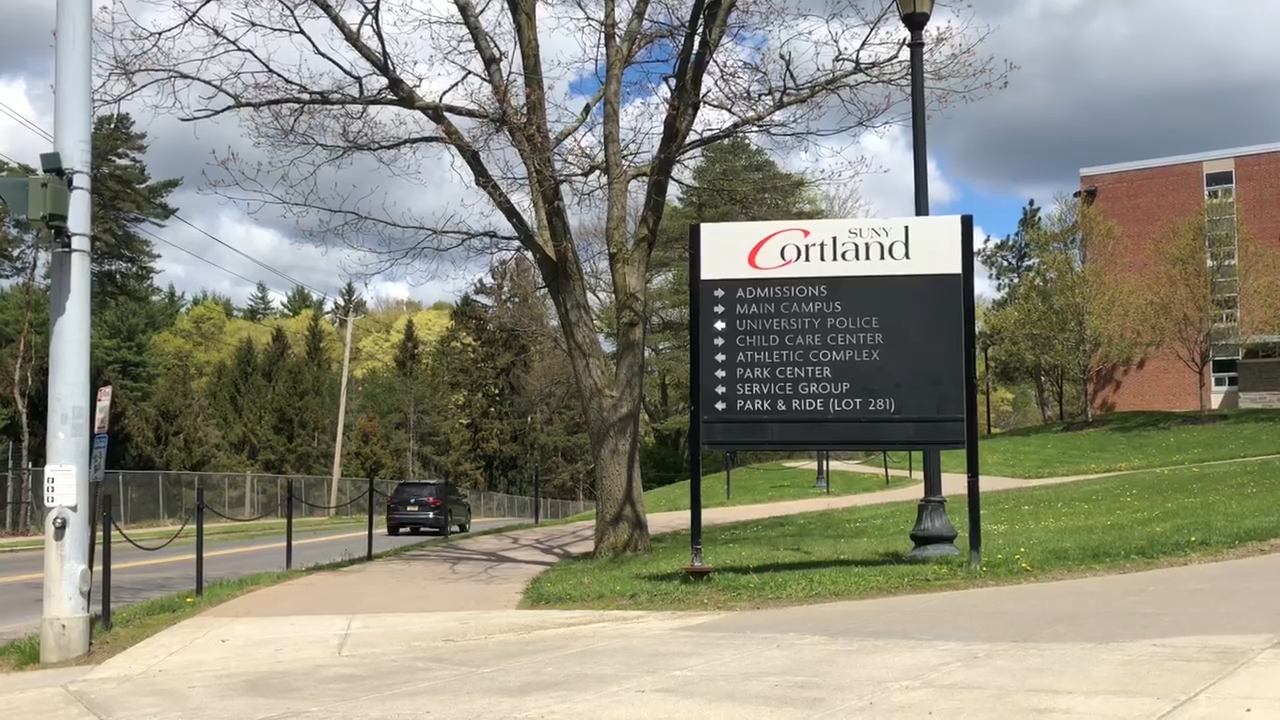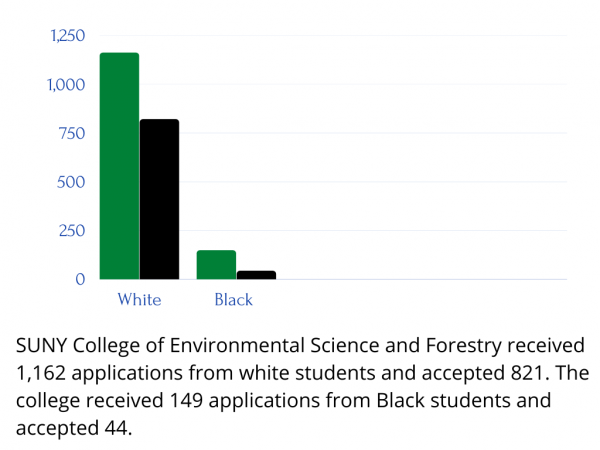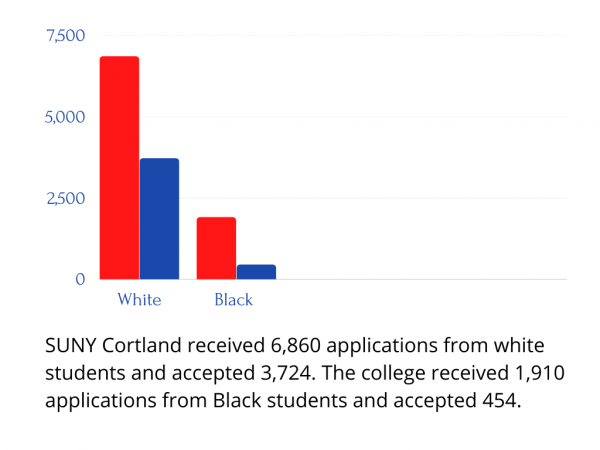Doug Cortese: For months, our team analyzed the acceptance rate of different races at SUNY schools across the state, we found a wide gap between the acceptance rate of white students and the acceptance rate of black students. This is how we told the story.
Cyera Williams: Okay, so as far as coming up with the story idea, I think it really stemmed from the not again SU protests on Syracuse campus, and starting to look at, you know, really the difference of diversity amongst the students here. And SUNY schools, we started looking at how life can be different for black students, for Asian students, for Island students and for white students. And that kind of just snowballed into, you know, well, what is the acceptance rate for the school
Ryan Arbogast: It ended up being much harder than a lot of the other stories we might have tried to pursue
Caleb Britt: Things change, stories change, and you have to adapt to it and I think we did that very well.
Cortese:The runaround we got just to obtain what ended up being public data was pretty eye opening. But I think it’s pretty indicative of how this field kind of works.
Britt:I believe that the data went back in to like 2014 2015. So to see that this was nothing new, I mean, was just mind boggling.
Arbogast: And coming from almost a resident Excel analyzer that kind of ran through all of the I believe, 138,000 cells of data that we ended up being publicly available, it was really discouraging to see that progression. Because while our country’s not in a position of perfection, we’ve heard that term racial promise or movement forward in the past, and this data showed, at least to me that that progress is very on the surface
Williams: We look at the acceptance rate as a whole, if the acceptance rate is 54%, that means my black self, my Asian counterpart, my white counterpart has a 54% chance of getting admitted into the school. But then you have to scroll down this, this, this 100 and whatever page excel sheet, just to find out that it’s, you know, from the interviews were like, Oh, it’s not required, but it’s there. It’s like, what’s the point? You know, just really checking a box shows that there are some disparities within the school system that nobody’s looking at.
Arbogast: I remember we had a conversation early on about that run around and how the pushback from the schools almost made us want to do the story more, because we felt as if, if they’re not willing to talk to us, they’re willing to hide something. And we saw that by schools that did want to hide some things by not appearing on camera.
Cortese:I don’t think I’ve ever been as pushy with sources or potential choices that I was
when executing this story.
Ryan Arbogast: People forget that we were days away from moving on. Yeah.
Cortese: Anytime you talk about accountability, I would say that, that ranges from everyone from the admissions people who are making these decisions, but also, I would say right down to the foil officers who we called. And for them, you know, they’re supposed to be, you know, I guess, somewhat transparent. And for them to just not be able to send a document, which is really all it was, there’s a URL to a document. I mean, I think it speaks to,
you know,I just think it speaks volumes that they that they didn’t do that either.
Arbogast: Well, the job of the foil officer, which is to provide information to the people that requested and for certain government entities and things say, the Onondaga County Department of Health, which is one that we looked into, they probably get a solid amount of requests. How many requests does SUNY Potsdam get on a regular basis? I would like to assume not many, and yet they still couldn’t fulfill ours.
Williams: The piggyback off of that a lot of the and we’re still trying to figure out whether or not this is true, but because of COVID-19, the remote offices of remote working from all that see staff members, it just made it even harder to reach the people who we actually needed to talk to SUNY Cortland was able to admit their faults and say, Hey, listen, we’re trying to get it right. This, they’re just a very, very small piece of the story. There’s so there’s so many SUNY schools, there’s so many, you know, state schools, there’s so many Ivy League schools that have the same racial disparity that will not acknowledge the data until the spotlight team brings it to light
Britt: And the thing is, I love sitting back and watching the interview unfold because I think going into it I was like, I’m not sure how this man is about to come across is going to be angry or whatever like that. But for him to sit there and be so calm and
One of the questions I believe Ryan asked him was, if you were to go out, will you say your school is diverse? And he said, No, I wouldn’t. But I would say they were working towards it. I mean, as simple as that. I mean, I think, again, I feel like any other school would be like, yes, we are diverse. Here are some numbers. But for him to say like, I wouldn’t say that, but we’re working towards it.
But how much? How better can you get from that kind of answer? Like he’s admitting that the school is not as diverse as you couldn’t be, but we’re actually taking steps towards it. Now. Do we know everything that they’re doing? No, you know, but still, I think he did a great job at taking accountability for it. And again, opening our eyes to other issues that could be impacting this.
Arbogast: Well, Caleb, you sat through the whole interview, he seems very strict and PR. In the beginning, yeah. And as we went along, throughout the interview, he seemed to relax and become more honest. Yeah, and some of the greatest sound and some of the greatest things he told us, were 15-20 minutes into the conversation, because we’re able to make him comfortable, and make him realize that this is an issue. And it didn’t seem like he didn’t believe it.
Cortese: To your point about sounding PR. It made me think of the student associate the student president for Cortland. And I remember being like seven minutes into that interview. And I was like, I don’t think we’re getting the sound that we need. So I just pulled up the data. And I started just like, kind of throwing it at her and being like, pick a year. And then you know, she’d pick a year. And I’d be like, well, this is how many white students apply to your institution. This is how many got in. And then I would do the same thing for African American students. And to see her reaction. It was, you know, you could see the look on her face, like the look of like, kind of like shock and horror. And not only did she react, but the other person in the office turned around from her desk. And she also said something to us, and she wasn’t even part of the interview. Alright, how about a wrap up, if we could just like go around and say, you know, maybe one thing we learned doing this investigation or from the class
Arbogast: People that are wrong, or scared, you’re going to make them look bad, we’ll never speak to you.People that are scared that your story is going to hurt their career, their public opinion, or whatever that might be, we’ll do everything in their power to find a way to get away from you. And I think we learned that very much, because this isn’t necessarily a smear piece, because it’s accurate. But it is a negative piece on these schools. And we learned very quickly that nobody wanted to help us because they all knew we were right.
Britt: Or maybe the two biggest things were patients because I feel like we’re so used to doing the daily turnaround things or stories. And so if one person doesn’t email back, or answer the phone off to the next person, you know, but for this, we had to stick with it and be patient and send 1000 emails, make a ton of phone calls, and wait for them to answer back. And again, we got a great story out of it. So of course that patience paid off. But you know, for the right things, you have to wait. And so that was one lesson. Secondly, to just the importance of holding people accountable. Because I think we saw that for sure. And this that why people hiding and trying to you know, ditch and digest when what it’s want to know, you know, what you’re doing doesn’t have to be a bad thing. But just update us on what you’re doing.
Williams: Being uncertain, is a horrible way to live. But you just have to do it when it comes to these investigative pieces. You know, because starting with, you know, the story idea, and our player requests, nobody answering back to them to the data coming in and Ryan having to go and read through each one trying to understand what those numbers mean. And then trying to figure out a format of how these important numbers can be easily explained to our audience. Is this a level of uncertainty that you I mean, for me as an EP that I just lived in, you know, I just have to be okay with nothing, not knowing for sure what it’s going to look like, what the sights are going to sound like, what the data is going to represent and how it comes across. It’s just, it is what it is, but, and being uncertain, I learned that it’s okay to be patient.
Cortese: Thanks for listening to the NCC news podcast. For more on this story, go to NCC news.com for the NCC spotlight team. I’m Doug Cortese.









